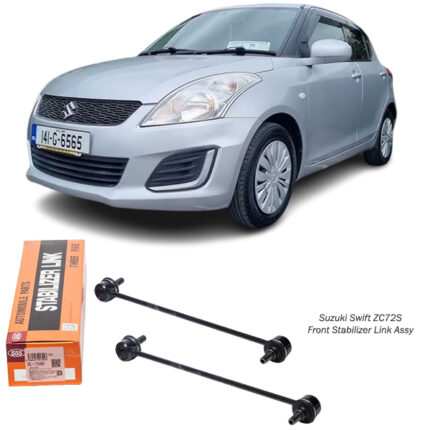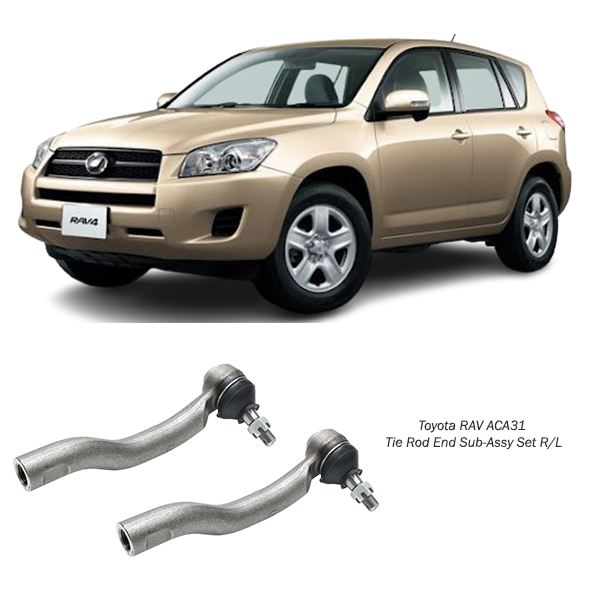-5%
Get Toyota Rav4 ACA31 Tie Rod End Sub-Assy Set R/L SET221 in Kenya
The Tie Rod End Sub-Assembly Set is a critical component in a vehicle’s steering and suspension system. It plays a significant role in ensuring precise steering control, alignment, and overall vehicle stability. This guide delves into the intricacies of the Tie Rod End Sub-Assembly, covering its functions, benefits, maintenance tips, and replacement considerations.
What Is a Tie Rod End Sub-Assembly Set?
The Tie Rod End Sub-Assembly Set consists of the tie rod ends and associated components that link the steering rack to the steering knuckle. These components translate the driver’s steering inputs into wheel movements, enabling smooth and controlled vehicle handling. The set typically includes:
- Inner Tie Rod Ends:
Connected directly to the steering rack, these components are responsible for transmitting force to the outer tie rod ends. - Outer Tie Rod Ends:
Linked to the inner tie rod and the steering knuckle, these components facilitate wheel pivoting during steering. - Fasteners and Bushings:
Ensure a secure connection and reduce vibration or play in the assembly.
How Does the Tie Rod End Sub-Assembly Work?
The Tie Rod End Sub-Assembly connects the steering rack (or gearbox) to the wheels. When the steering wheel is turned:
- The steering rack moves laterally.
- This movement is transferred through the inner tie rod ends to the outer tie rod ends.
- The outer tie rod ends pivot, moving the steering knuckle and turning the wheels in the desired direction.
This precise coordination allows for responsive and controlled steering, ensuring the vehicle maintains alignment and stability.
Functions of the Tie Rod End Sub-Assembly Set
- Steering Control:
Directly links the steering mechanism to the wheels, enabling accurate directional control. - Wheel Alignment Maintenance:
Keeps the wheels aligned to the correct toe angle, preventing uneven tire wear and improving fuel efficiency. - Shock Absorption:
Reduces vibrations and road impacts, offering smoother steering and ride comfort. - Load Distribution:
Transfers and balances the lateral force exerted during turns across the suspension system.
Benefits of a Well-Maintained Tie Rod End Sub-Assembly
- Enhanced Vehicle Safety:
A properly functioning tie rod end ensures predictable steering response, reducing the risk of accidents. - Improved Tire Longevity:
Maintains proper alignment, minimizing uneven tire wear and extending tire life. - Smooth Steering Operation:
Eliminates play or stiffness in the steering wheel, allowing for precise control. - Cost Efficiency:
Prevents damage to other steering and suspension components, reducing repair costs over time.
Common Signs of a Faulty Tie Rod End Sub-Assembly
- Uneven Tire Wear:
Misaligned wheels caused by a worn tie rod end lead to irregular tire wear patterns. - Steering Wheel Vibrations:
Loose or damaged tie rod ends can cause vibrations, particularly at higher speeds. - Loose Steering Feel:
Excessive play in the steering wheel may indicate a worn tie rod end. - Noises During Turning:
Clicking or squeaking sounds while steering often signal wear or damage to the tie rod ends. - Vehicle Pulling to One Side:
Misalignment caused by a faulty tie rod end may result in the car veering to one side during driving. - Difficulty Maintaining Alignment:
Frequent need for wheel alignment adjustments could point to a failing tie rod assembly.
Causes of Tie Rod End Sub-Assembly Wear
- Normal Wear and Tear:
Regular use leads to gradual wear of the ball joints, bushings, and threads. - Harsh Driving Conditions:
Off-road driving, potholes, and rough terrain accelerate wear on tie rod ends. - Lack of Maintenance:
Insufficient lubrication or failure to address minor issues promptly can worsen wear. - Corrosion:
Exposure to water, salt, and dirt can corrode metal parts, reducing their lifespan.
Maintenance Tips for Tie Rod End Sub-Assembly
- Regular Inspections:
Periodically check the tie rod ends for signs of wear, such as looseness, cracks, or corrosion. - Keep Components Lubricated:
Apply high-quality grease to the ball joints and threads to minimize friction and wear. - Align Wheels Periodically:
Schedule wheel alignments as part of routine vehicle maintenance to ensure even wear and optimal steering performance. - Avoid Overloading:
Excessive vehicle weight stresses the steering and suspension systems, accelerating component wear. - Drive Cautiously:
Minimize sudden impacts by avoiding potholes, curbs, and rough terrain when possible.
Replacement of a Tie Rod End Sub-Assembly
When to Replace
- Persistent steering issues or alignment problems.
- Visible damage, such as cracks or corrosion.
- Excessive play in the tie rod ends during inspection.
Steps for Replacement
- Secure the Vehicle:
Use a jack and jack stands to lift and stabilize the vehicle. - Remove the Wheel:
Detach the wheel to access the tie rod assembly. - Loosen the Tie Rod End:
Use a wrench to remove the nut securing the tie rod end to the steering knuckle. - Detach the Tie Rod End:
Use a tie rod puller or hammer to free the tie rod end from the knuckle. - Mark the Thread Position:
Mark the current position on the threaded rod to maintain alignment when installing the new tie rod end. - Install the New Tie Rod End:
Screw the replacement tie rod end onto the rod, ensuring alignment with the marked position. - Secure the Assembly:
Reattach the tie rod end to the steering knuckle and tighten the nut to the recommended torque. - Reinstall the Wheel:
Mount the wheel and lower the vehicle. - Perform Alignment:
Conduct a wheel alignment to ensure the steering system is correctly adjusted.
Aftermarket Options for Tie Rod End Sub-Assemblies
- OEM (Original Equipment Manufacturer):
Ensures compatibility and reliability, ideal for most drivers. - Heavy-Duty Options:
Designed for off-road or heavy-load vehicles, offering increased durability. - High-Performance Sets:
Feature advanced materials and designs for improved steering response and longevity.
Advantages of Upgrading Tie Rod End Sub-Assemblies
- Enhanced Durability:
Upgraded components withstand harsh conditions better than standard options. - Improved Steering Response:
High-performance tie rod ends provide quicker and more accurate steering feedback. - Reduced Maintenance Needs:
Premium materials and designs often require less frequent upkeep.
Environmental Considerations
Dispose of worn-out tie rod assemblies responsibly by recycling metal components. Many repair shops and recycling centers accept these parts, reducing environmental impact.
Conclusion
The Tie Rod End Sub-Assembly Set is vital for maintaining precise steering control, proper alignment, and overall vehicle safety. Regular inspections, timely maintenance, and high-quality replacements ensure these components perform effectively. Whether navigating city streets or rugged terrains, a reliable tie rod assembly is key to a safe and comfortable driving experience.
Follow us on Facebook for more parts.




